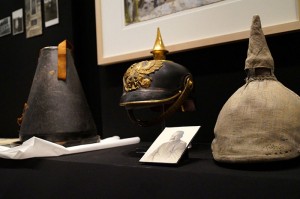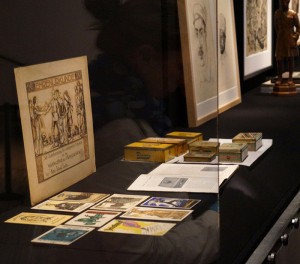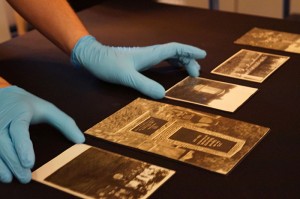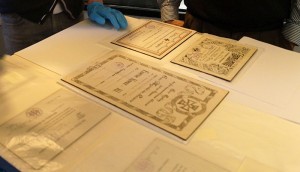Or: How 300 Artifacts from our Collection Were Turned into a Cabinet Exhibition about the First World War

Objects from our collections in the exhibition “The First World War in Jewish Memory”
© Jewish Museum Berlin, photo: Mariette Franz
Our exhibition “The First World War in Jewish Memory” opened last week. It is based primarily on collections donated to the Jewish Museum by German-Jewish families and each exhibit tells a very personal story.
In total, 176 exhibits were selected, researched and arranged as a visual narrative by eight curators, six restorers, two exhibition technicians, a translator and a graphic artist. So, even before I mention our numerous willing helpers in the wings, in particular the student assistants and the Museum caretaker, this sounds like a big team for a big exhibition. In fact, our joint endeavor culminated in a small cabinet exhibition relating to the First World War, which can be viewed until 16 November in the Rafael Roth Learning Center.
Our first task was to decide which exhibits even came into question. Since we wanted to draw exclusively on in-house collections, we were at least spared the trouble of researching and arranging the loan of objects held by other museums and institutions. Nevertheless, we still had to choose from among the 3,000 objects held alone in the Jewish Museum’s collections of First World War memorabilia. One object made it into the exhibition just in time: the small box with the label “Feldpost 1914–15,” which is on display at the rear of the showcase, arrived to our complete surprise in a package from Uruguay only ten days before the opening. This box is thus the most recent acquisition on show in the exhibition.
Once the selection process was complete, the real work began. All the exhibits were taken to the restoration department and, since the majority were documents, the paper conservators had an especially heavy workload. Then came the photo shoot, so that exhibits would be available for online viewing from the day the exhibition opened. Texts were written, edited and translated, laid out by a graphic artist and then printed. Countless minor decisions had to be made and coordinated: How long should the text about each exhibit be? Which material should be used for labels, and which color? And in which font should the text be set? It was rapidly decided that the display cabinets should be lined with black fabric—but, of course, with a certified black fabric that would not prove detrimental to the exhibits on display. Three days before the opening, we were ready to begin setting up. Even though the sequence and approximate position of each exhibit had been decided in advance, further fine-tuning was necessary in order to establish the exact interrelation of graphics, letters from the front, labels and the like. For two and a half days our conservators were kept busy positioning the exhibits precisely as the curators intended. As project coordinator, I accompanied this entire process and thus had a unique opportunity to familiarize myself in greater detail with our collections.
Although individual biographies are not the explicit exhibition focus, closer inspection, especially of the numerous documents, brings personal fates to the fore. I was particularly moved by three objects that seem initially, quite unremarkable yet which throw light on the tragedy of early twentieth-century German-Jewish biographies. I’m talking about the three certificates awarded in combination with an Order of Merit to Herbert Meyer, Herbert Swallow and Louis Simon for their respective services to the nation as front-line soldiers in the First World War. Hindenburg introduced this medal in 1934 to mark the twentieth anniversary of the First World War—and to honor not only non-Jewish but also Jewish veterans. It was awarded only on request and the certificates in our possession show that applications for the medal were submitted between 1935 and 1937 not only in Berlin, but also in Paris and Tehran. Recipients in the latter cases filed applications with their local German consulate—after having been forced to flee persecution by the very country for which they had fought and risked their lives only twenty years earlier.
Mariette Franz, Museum Assistant
PS: Details of these certificates and other exhibits will be available shortly in a video-clip format on our YouTube channel.


